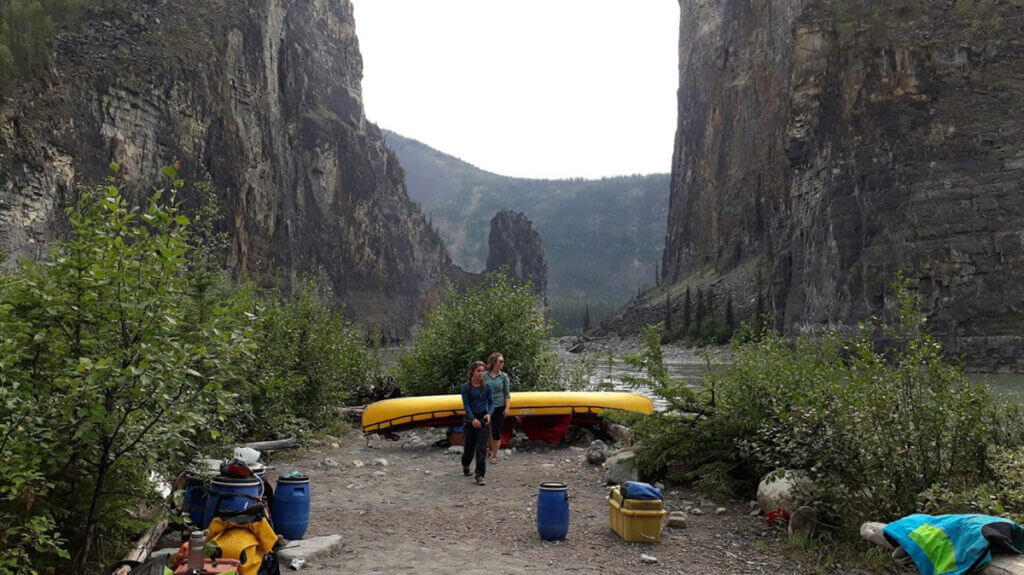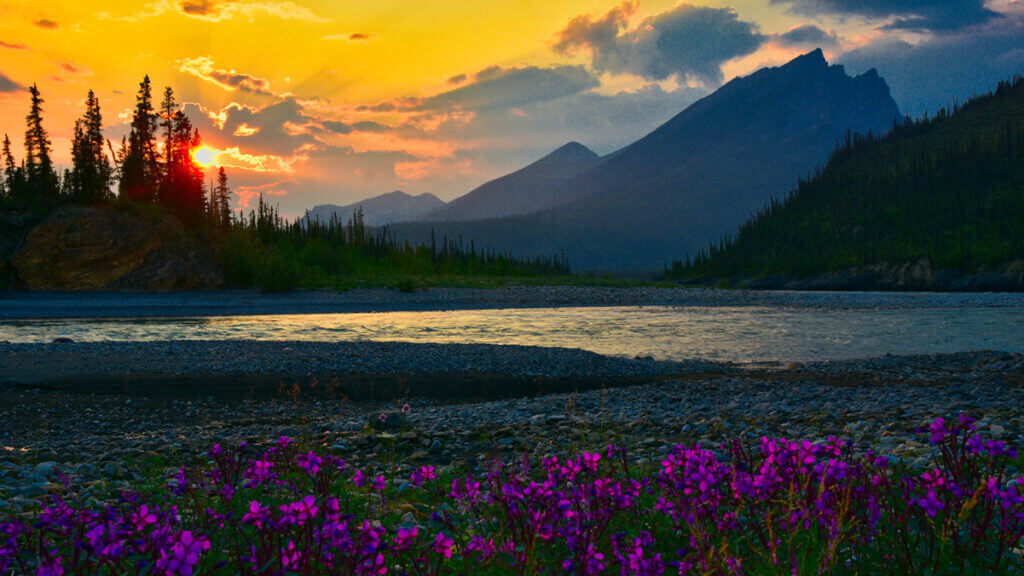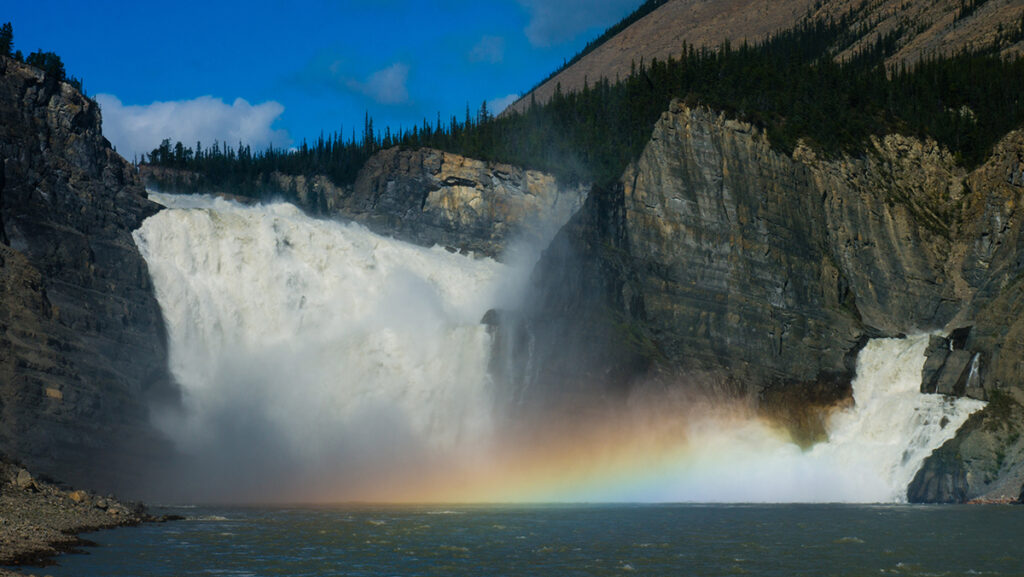River Trips of the Nah?ą Dehé (Nahanni River) Watershed
By Willa Mason, Guide and Instructor
Flowing west to east through the Territories of the Sahtu Dene, Métis, and Dehcho Dene, the Nahʔą Dehé (South Nahanni River), is one of the most sought-after river trips in the world.
The river stems from three main tributaries and is more than 540 km long. The entire system runs through two different National Park Reserves, the term used for a nationally protected area in which Indigenous Peoples maintain the rights to hunt, travel, and work within the Reserve boundaries.
You can read more about these protected areas from the Parks Canada websites on the Nahanni and Nááts’įhch’oh National Park Reserves.
There are many options for running this river that offer flexibility in trip duration, whitewater difficulty, and scenery. Below, we’ve broken down the options based on these factors, in the order that they join Nahʔą Dehé (South Nahanni River) from west to east.
If a paddler were to begin at Nááts’įhch’oh Tué (Moose ponds) and paddle downstream, they would see where Łáhtanįlį Deé (Little Nahanni River) joins the main river, then Pı̨́ı̨́p’enéhłéetǫ́ǫ́ Deé (Broken Skull River), before reaching Gahnîhthah Mįe (Rabbitkettle Lake), and continuing downstream towards Náįlįcho (Virginia Falls), and finally the rest of Nahʔą Dehé (South Nahanni River). We’ve included the Indigenous place names alongside the English ones, when possible.
Flowing through three Traditional Territories, we have used the corresponding Indigenous names in the Shúhtaot’ine and Dene Zhatıé languages. Some of the places have been renamed by Elders in recent years, where names have been lost or forgotten. We’ve used English only where we were unable to find the Indigenous name. You can visit the Place Name Pronunciation Guide for more information. The River of Forgiveness film project is a great watch to understand the history of Nahɂa Dehé, as well as the relationship between Sahtu Dene and Dehcho Dene.
To jump ahead—click on a river section:
1. Nááts’įhch’oh Tué (Moose ponds)
2. Łáhtanįlį Deé (Little Nahanni River)
3. Pı̨́ı̨́p’enéh łéetǫ́ǫ́ Deé (Broken Skull River)
4. Gahnįhthah Mie to Náįlįcho (Rabbitkettle Lake to Virginia Falls)
5. Náįlįcho (Virginia Falls)
6. NahʔąDehé (South Nahanni River)

1. Nááts’įhch’oh Tué (Moose ponds)
Language: Shúhtaot’ine dialect
Territory: Sahtu Dene and Métis
Difficulty: Advanced canoe trippers or packrafters
Whitewater: Class II-III (technical and remote)
Length: 90 km to Gahnįhthah (Rabbitkettle)
Typical duration: 5 to 9 days (most groups continue on to the lower sections for a total of 18 to 24 days)
Starting point: Nááts’įhch’oh Tué (Moose ponds)
Access from: Tlegohli (Norman Wells)
Recommended season: Late June to Late July
Typical watercraft: Canoe, packraft
Geography
Considered to be the true headwaters of Nahʔą Dehé (South Nahanni River), this river starts out as a tiny creek, before gaining volume as more tributaries join the river and it becomes Nahʔą Dehé. It flows through Nááts’įhch’oh National Park Reserve and then into Nahanni National Park Reserve.
Geology
Shúhta (Central Mackenzie Mountains) is the northeastern branch of the Rocky Mountains. Fish specimens have been dated to 400 million years ago, and many fossils of aquatic species indicate that parts of this area were once submerged. The first campsite of the trip has the park’s namesake towering over it: Nááts’įhch’oh (Mt. Wilson). Its presence is humbling, and it’s known as the mountain with díígóɂo (prehistoric power).
Overview
Nááts’įhch’oh Tué (Moose ponds) is home to tight, technical, challenging whitewater. Here, river runners have the experience of starting from the very headwaters of a creek, and travelling downstream as the channel grows beneath them. Over time, the creek turns into a river, and paddlers navigate between tightly placed boulders for five days. The river then begins to flatten out, and rocky sections give way to bigger waves and deeper water. A skill testing playground, this section is sure to satisfy the adventure cravings of the most seasoned whitewater canoeists, a fantastic prequel to the scenic grandeur (and slightly more relaxing whitewater) of the Nahʔą Dehé.
Guide’s opinion
“Moose ponds is challenging whitewater, super fun for the accomplished whitewater canoe tripper. If your whitewater appetite is big enough, it is an awesome trip!”
- Rob Norton, Blackfeather guide, Boreal River guide and instructor
2. Łáhtanįlį Deé (Little Nahanni River)
Language: Shuhtaot’ine dialect
Territory: Sahtu Dene
Difficulty: Advanced canoe trippers or packrafters
Whitewater: Class II-III+ (technical and remote)
Length: 85km
Typical duration: 3 to 6 days (most groups continue on to the lower sections for a total of 12 to 17 days)
Starting point: Flat Lake
Access point: Łı́ı́dlı̨́ı̨́ Kų́ę́ (Fort Simpson)
Recommended season: July
Typical watercraft: Canoe, packraft
Geology
After being submerged, Shúhta (Central Mackenzie Mountains) were formed by sedimentary rock layers pushing upwards, an uncommon phenomenon for mountain formation so far away from the nearest boundary between tectonic plates.
Overview
Known for being home to the most challenging whitewater of all the Nahʔą Dehé (South Nahanni River) tributaries, the Łáhtanįlį Deé (Little Nahanni River) is less frequently explored by paddlers. This river is accessible by road, a five hour drive from Łı́ı́dlı̨́ı̨́ Kų́ę́ (Fort Simpson). If you have lots of experience under your belt and you’re looking for the ultimate challenge, this is the one for you! After landing at Flat Lake, there is one day of tight, technical whitewater paddling, before entering the canyon section of the river. The first of three is home to a steep rapid. Most people opt to lift over or portage around this one. The two remaining canyons are friendlier than the first, but thrilling technical whitewater is sure to keep you on your toes, and a smile on your face.
Read a trip description of the Little Nahanni in Rapid Magazine here.
Guide’s opinion
“The adventure starts on the drive in. Foreshadowing for the rest of the trip, the switchbacks down to the river are sure to get your palms sweating. In my opinion the hardest and prettiest river in the area, the Little Nahanni is sure to be epic…at least a bit.”
- Paul Mason, Canoe instructor and former wilderness guide

3. Pı̨́ı̨́p’enéh łéetǫ́ǫ́ Deé (Broken Skull River)
Language: Shúhtaot’ine dialect
Territory: Sahtu Dene and Métis
Difficulty: Intermediate canoe trippers or packrafters
Whitewater: Class I-II+
Length: 150 km
Starting point: Ǫtaa Tu Fehto (Divide Lake)
Typical duration: 8 to 12 days—some groups continue on to run the whole NahʔąDehé (South Nahanni), which would add an additional 9 to 16 days
Access from: Tlegohli (Norman Wells)
Typical watercraft: Canoe, packraft
Recommended Season: Late June to mid-August
Geography
Pı̨́ı̨́p’enéh łéetǫ́ǫ́ Deé (Broken Skull River) flows south into NahʔąDehé (South Nahanni River). The confluence is located downstream of Nááts’įhch’oh Tué (Moose ponds) and Łáhtanįlį Deé (Little Nahanni River), upstream of Gahnįhthah Mie (Rabbitkettle Lake). It begins in Nááts’įhch’oh National Park Reserve, and enters Nahanni National Park Reserve just before joining NahʔąDehé. The nearby Sahtu communities of Tulita and Normal Wells are home to many Sahtu Dene and Métis Peoples, and the Shúhtaot’in dialect is used for names within Nááts’įhch’oh National Park Reserve.
Geology
The headwaters of Pı̨́ı̨́p’enéh łéetǫ́ǫ́ Deé (Broken Skull River) are in the Selwyn mountains, then the river flows through Shúhta (Mackenzie Mountains). Being a smaller river, paddlers are never more than a few metres away from colourful, swirling peaks. Sometimes it may feel as though they stem right out of the very water you’re floating on. Downstream, paddlers get their first taste of braided gravel channels. On your final days before paddling into Gahnįhthah Mie (Rabbitkettle Lake), you will see the spectacular spires of the Ragged Range. The highest peaks in the Northwest Territories, they were formed 110 million years ago. The skyrocketing towers of hard granite are a stark juxtaposition from the wide alpine meadows of Ǫtaa Tué Fehto (Divide Lake).
Overview
Starting at Ǫtaa Tué Fehto (Divide Lake), this river trip lets canoeists experience the growth cycle of a waterway. From the lake, a tiny trickle floats paddlers towards the Pı̨́ı̨́p’enéh łéetǫ́ǫ́ Deé (Broken Skull River), where you will be treated to ever-changing scenery, technical rapids, and diverse campsites. The whitewater requires fun, technical maneuvering to avoid rocks. It’s easier with higher water, as lower water levels expose more rocks to avoid! When it has been raining, the river feels tropical, filled with bright blue water. Watch the effect of silt on a waterway firsthand, as a quick rain shower will turn the water milky.
Pı̨́ı̨́p’enéh łéetǫ́ǫ́ Deé (Broken Skull River) then joins NahʔąDehé, as you feel the volume of the river multiply beneath you and sense the valley widen around you. Most outfitters also offer the option to continue downstream for an additional two weeks all the way to Nahanni Butte. For paddlers with many canoe trips under their belt, consult the Parks Canada trip planner. Imagine yourself on this northern river by exploring more details here.
Guide’s opinion
“The rapids are less technical than other rivers, but the continuous whitewater makes it just as fun. It feels like the mountains soar straight out of the river beside you as you’re paddling. Add in the unrivaled hiking, and paddling the Brokenskull down to Nahanni Butte is the trip I’d choose if I could only paddle one northern river with my family”
- Caleb Roberts, wilderness guide with Blackfeather and Boreal
River Adventures
Guide Caleb Roberts compares the Broken Skull and Moose Ponds
4. Gahnįhthah Mie to Náįlįcho (Rabbitkettle Lake to Virginia Falls)
Language: Dene Zhatıé
Territory: Dehcho Dene
Difficulty: Beginner
Whitewater: None
Length: 117 km
Duration: 2-4 days
Starting point: Gahnįhthah Mie (Rabbit Kettle)
End point: Náįlįcho (Virginia Falls)
Access from: Łı́ı́dlı̨́ı̨́ Kų́ę́ (Fort Simpson)
Recommended season: June to September
Typical watercraft: Canoe
Geography
A popular starting point, this section is nestled just beyond the Ragged Range. After admiring the granite peaks, the Sunblood Range will come into view after a day or two of paddling.
Geology
The geological highlight in this section is Gahnhthah (Rabbitkettle) tufa mounds. The water here, heated by volcanic energy 2,000 metres below the surface, is highly saturated with calcium carbonate. The temperature cools as the water approaches the surface, lowering its saturation point, and causing the minerals to be deposited in a solid form. Forming small terraces and pools, called rimstone dams and gours, the tufa has gradually grown into an impressive tower over which the spring water flows. Thirty meters high and 60 meters wide, the largest mound is thought to be 10, 000 years old.
Overview
While not completed as a standalone river trip, this is an optional section amongst river trip variations. An egress point for concluding river trips down Pı̨́ı̨́p’enéh łéetǫ́ǫ́ Deé (Broken Skull River), Nááts’įhch’oh Tué (Moose ponds), or a climbing trip in the Cirque of the Unclimbables, Gahnįhthah Mie (Rabbitkettle Lake) is also a special stopping point in the midst of a longer trip, or a starting point for trips down NahʔąDehé (South Nahanni River). An awe-inspiring emerald blue lake is refreshing enough to strip away all the river trip grime, and a spectacular view of the Vampire Peak will fill your sights.
The lake is one of the few spots along the river where Parks Canada maintains a cabin for park wardens. Happy to answer questions while escorting visitors to the tufa mounds, staff help ensure the visit is done in a respectful way that minimizes visitor impact on the space. Walking barefoot and stepping in specific places, visitors may feel the sharp tufa beneath their feet.
Afterwards, a short portage leads paddlers from the lake to NahʔąDehé. The next couple of days feature swirling currents and fast-moving water, but no notable rapids. Winding its way through a large, post glacial valley, the valley feels similar to what you might find on the prairies—its an impressive juxtaposition to the canyons that await you in only a few days. If the wind is blowing in the right direction, it won’t be long before the sound of Náįlįcho (Virginia Falls) fills your ears.

5. Náįlįcho (Virginia Falls)
Language: Dene Zhatıé
Territory: Dehcho Dene
Access from: Łı́ı́dlı̨́ı̨́ Kų́ę́ (Fort Simpson)
Geography
Framed by the Sunblood Range, Náįlįcho (Virginia Falls) marks the end of the calm section, located just upstream of Fourth Canyon and Tu Naka Dé (Flat River).
Geology
Dropping 92 metres in total, Náįlįcho is an impressive sight. As erosion slowly caused the waterfall to migrate upstream, one soaring rock tower has resisted erosion and foreshadows the towering rock walls that await below. Fourth Canyon, the first of the four canyons downstream from the falls, is a result of the gradual erosion caused by the waterfall.
Overview
Featuring outhouses and a boardwalk (a luxury in the park reserve!) Náįlįcho is one of the few places where the impacts from tourists and paddlers is noticeable. A jarring juxtaposition from the landscape upstream, it’s a valuable cause for reflection and helps us consider the impact of our travel on the environment. In this instance, the extensive boardwalk protects delicate vegetation and permafrost, helping to break the correlation between increased visitors and increased damage. We’re still able to observe the intricate ecosystem because the boardwalk protects it from our feet. I guarantee you’ll be singing the praises of the boardwalk on your third trip over it with a gear pack!
Travellers must reserve the dates of their maximum two-night stay here, so that all visitors passing through can enjoy the must-stop campsite and information sessions from the Parks Canada staff.
6. NahʔąDehé (South Nahanni River)
Language: Dene Zhatıé
Territory: Dehcho Dene
Difficulty: Beginner-friendly for rafters in guided rafts, intermediate for canoe trippers or packrafters
Whitewater: Class I-II (high volume = big waves)
Length: 240 km
Starting point: Náįlįcho (Virginia Falls)
End point: Ttenáágó (Nahanni Butte)
Typical duration: 7-14 days
Access from: Łı́ı́dlı̨́ı̨́ Kų́ę́ (Fort Simpson)
Typical watercraft: Raft, canoe, packraft, paddleboard (SUP)
Recommended Season: June to September
Geography
NahʔąDehé (South Nahanni River) flows southeast through Nahanni National Park Reserve. The park boundary is just upstream of its confluence with the Liard River.
The NahʔąDehe Consensus Team was formed to help manage Nahanni National Park Reserve jointly by Parks Canada and the Dehcho First Nations. Comprised of three Parks Canada appointees and four Dehcho appointees, the team is responsible for addressing matters such the management of sites with spiritual and/or cultural significance, including historical habitations and burial sites within the park boundaries. Guidelines and applications for research permits, commercial licences or other activities are also assessed and addressed by the team.
Dehcho First Nations may use motorized vehicles to travel through Nahanni National Park Reserve to facilitate their hunting, fishing, trapping, and harvesting activities. The endpoint is Ttenáágó (Nahanni Butte), home to the Nahɂa Dehé Dene Band.
Geology
NahʔąDehé has followed nearly the exact same path for over 200 million years. As the rocks around it began to lift up, the river eroded its path. An antecedent river, it has been flowing since before the mountains were formed.
As the powerful falling water of Náįlįcho (Virginia Falls) eroded the rock beneath it, sheer cliffs were left on either side. This is how the seemingly painted walls of Fourth Canyon were formed, whereas Third Canyon has wider slopes made of sandstone and shale. As it twists its way through the mountains of the Funeral Range, most of Third Canyon’s limestone surrounds a feature that paddlers call “The Gate,” where the river slips through a narrow gap bordered by 460 meter high limestone walls. Second Canyon slices through the Headless Range, and prefaces some of the largest alluvial fans in Canada. The best is truly saved for last, as the resistant limestone and dolomite of First Canyon rise to a height of 1000 meters. In this area, rainfall has dissolved the limestone to create karst formations, which include the caves and tunnels you will see along the way. Travellers are not permitted to enter the caves, but the entrances themselves are impressive.
Overview
For a paddler travelling downstream, it may seem as though the canyons are named in reverse order. For prospectors travelling upstream against the current however, it would have seemed completely logical!
Whether paddlers begin at Gahnįhthah Mie (Rabbitkettle Lake), Náįlįcho (Virginia Falls), or farther upstream on one of the tributaries, this section contains many of the landmarks this river system is known for. Infinite hiking opportunities serve as motivation to extend the trip as long as personal time restrictions permit. Featuring much friendlier whitewater than its upstream tributaries, NahʔąDehé will still get every paddler’s hands sweating, face grinning, and heart pumping. With everything from small swifts to long, challenging rapids, this section of river features big waves with minimal rocks, making it friendly for both large rafts and tandem canoes.
Guide’s opinion
“Everyday there’s something completely new and spectacular to look forward to. Whether it’s the tufa mounds, the falls, the canyons, the hikes, or the hot springs, there’s always something unbelievably remarkable around the corner.”
- Hannah Pham, Blackfeather guide and ten-time Nahanni river tripper
More options
After navigating any of the three tributaries, paddlers can continue down the Nahʔą Dehé for 14 more days, adding a visit to Náįlįcho and 4 spectacular canyons to the trip. Most outfitters offer these options. Another popular variation, for paddlers looking to make the trip a full-body workout, is the option to take a break from the canoes and spend five days hiking into the Cirque of the Unclimbables.
From the challenging waters of Nááts’įhch’oh Tué (Moose ponds), Łáhtanįlį Deé (Little Nahanni River), and Pı̨́ı̨́p’enéh łéetǫ́ǫ́ Deé (Broken Skull), to the timeless whitewater and skyscraping canyons of Nahʔą Dehé, this watershed is truly home to a river trip for everyone.
Guiding Companies
For paddlers seeking a guided trip, there are multiple outfitters to choose from, including us at Boreal River Adventures. While each company offers highly qualified professional river guides and delicious camp food, each has its own unique flair, so it’s worth reading up on each one to see which experience best suits what you’re looking for.
Read about our Nahanni Trips here
We are striving to be accurate and respectful in our use of Traditional names of places and Peoples, yet we are bound to make mistakes. Please reach out to us anytime if you seen an error or something that can be improved. We welcome your feedback: info@borealriver.com
Links
Read: 6 Best Multi-Day Rafting Trips In Canada

